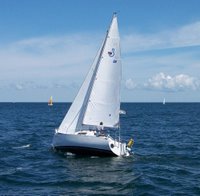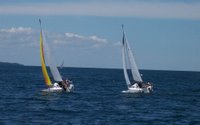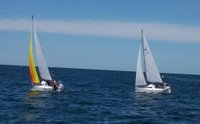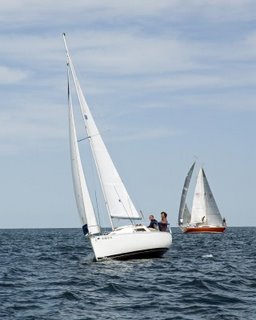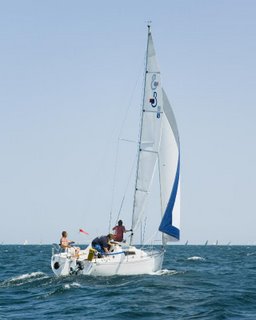10-man crew
Bow
Prestart:
Pulpit, shore ranges, call traffic, call line, run time, set pole, hookups
Tacking:
go forward under sail, pull jib across, skirt jib
Upwind:
lead man on rail, sail changes, hookups, pole reset,
Set:
assist chute under jib
Downwind:
sail resets/changes,
Jibe:
in pulpit, bring lazy guy forward, pull pole in w/foreguy, insert new forguy, call "MADE"
Douse:
in sewer pulling chute into forward hatch, assisting with pole down, call "CLEAR TO TACK" when clear
Mast
Prestart:
at mast or on rail, position on rail is 2nd behind bowman. Jump halyard on main set, jump halyard on jib set.
Tacking:
in front of mast, clear jib clew around shrouds
Upwind:
assist bow with sail sets or changes when needed. When possible stay on rail until needed, call puffs, windshifts and tide lines, top inboard end of pole as we come into the windward mark
Set:
jump spinnaker halyard, when up call "TWO-BLOCKED"
Downwind:
assist with pole top on mark rounding, assist with chute set if needed, adjust inboard pole end if needed, relead jib sheets for change, jump jib halyard on set
Jibe:
on "Prepare to Jibe" mast uncleats and raises mast end of pole to mark. on "Trip" mast pulls trip line to free working guy from pole jaw. on "Made" jump topping lift and resets pole inboard end in normal position.
Douse:
gathering chute in and feeding to bowman in the forward hatch. Get pole down as soon as is possible but do not sacrifice boatspeed to windward if it is not a priority. Do not drop pole on hatch or bowman's head. Assist bowman in clearing lines once pole is down to call for "Clear to Tack."
Mid
Prestart:
Rail, assist in jib set, if necessary. Help feed main into track. Stay behind mast unless necessary. Adjust cunningham, outhaul and vang as called by main trimmer.
Tacking:
Go under boom to new high side
Upwind:
3rd on rail behind bow and mast
Set:
Help jump halyard if necessary, assist pit with halyards if necessary
Downwind:
Vang on, dump outhaul and cunningham, listen for weight balance calls, help jump jib halyard if necessary, hold out boom if required
Jibe:
Release vang (check with main trimmer)
Douse:
Work with main traimmer to harden up outhaul, help gather if necessary or assist pit with grinding if necessary
Pit
Prestart:
Tail halyards for main and jib. Tension running backs if necessary (usually we leave runners off for prestart), Call time, relay messages forward, support bowman at all times -- every extra second she is *not* on the bow is time and speed saved. During final approach, set windward runner with main trimmer.
Tacking:
Move off rail to hatch way. On "Ready About" uncleat windward runner, on "Helm's Down" release old runner and tail in new windward runner, grind if necessary. Try to finish by the time the jib and main load up.
Upwind:
Rail 4th back between mid and chute grinder/tailer2, runner adjustments/halyard adjustments, flake jib halyard prior to set, top pole on final approach to mark.
Set:
Tail spinn halyard, release jib halyard
Downwind:
Weight balance, pole adjustments, spaghetti patrol Jibe: on "Square Back" set up topper to mark for release. On "Trip" open spinlock and release topper to mark. on "Made" tail in to bring pole up to previous position. Pole should come up as guy trimmer brings it back.
Douse:
Tail jib halyard for jib set, flake spinn halyard to cabin top, on "Douse" release spinn halyard until chute is over the water then watch for the gather and release halyard. Release topping lift when bowman/mast is ready.
Tailer2/chute grinder
( tailer will switch off with tailer 1 on tacking, as needed)
Prestart:
On rail, assist pit in grinding for jib halyard set
Tacking:
Under boom
Upwind:
On rail between pit and tailer 1, call puffs, wind lines, tide lines, etc.
Spinnaker Set:
Grinder for spinn sheet
Downwind:
Grinder for spinn sheet
Jibe:
Grinder on new spinn sheet and/or new guy if required
Douse:
Clear spinn sheet on douse
Tailer1/Chute trimmer
Prestart:
In cabin with trimmer
Tacking:
Tail in new jib sheet, tail up to high side while timmer grinds
Upwind:
On rail between tailer2 and trimmer
Spinnaker Set:
Pull back and trim sheet
Downwind:
Trim sheet
Jibe:
Sheet to sheet free fly with grinder standing by (if light enough)
Douse:
Clear sheet, lazy sheet and guy, tail for jib trimmer
Jib/Guy Trimmer
Prestart:
Trim jib to course
Tacking:
watch to clear jib sheet on low side, grind and trim jib
Upwind:
Trim jib (reach leads if needed for close reaching can be set), call traffiic
Spinnaker Set:
pull back and trim after guy/foreguy
Downwind:
Trim guy with chute trimmer
Jibe:
Slack lazy guy for bowman, tail back on new guy as soon as it's made while trimmer free flies sheets (if light)
Douse:
Let guy off, trim jib
Main Trimmer
(call to mid for cunningham, outhaul; pit for runner, vang; main trimmer does backstay, traveller, sheet (with fine tune)
Prestart:
Trim main, set backstay
Upwind:
Trim main, work traveller, on rail next to driver
Tacking:
Release jib sheet, trim main, work traveller
Spinnaker Set:
Trim main
Downwind:
Trim main, backstay off, backstay on before douse
Jibe:
Trim main, bring across, call "MAIN'S ACROSS"
Douse:
Trim main,
Tactics
Prestart:
Overall race strategy with crew, driver, call time, confirm shore ranges, time line, etc. Overall calls of sets, douses, etc. Tactical calls with other boats, traffic calls, current, wind shifts, etc.
Upwind:
Leeward watch, etc., then on rail behind driver, work with driver on layline
Tacking:
Stern rail to stern rail
Spinnaker Set:
Call set
Downwind:
Work with driver on downwind position for leeward mark rounding
Jibe:
Work with driver on lay line
Douse:
Call douse
Driver
Prestart:
Check line squareness, run/time line, luff for wind direction, close-hauled compass headings, transits for bowman's shore range, timed run of start, drive
Upwind:
Drive
Tacking:
Drive, call "READY ABOUT" call "HELM'S DOWN"
Spinnaker Set:
Bear off, call set or let tactician call set, drive
Downwind:
Drive
Jibe:
Call "SQUARE BACK" "TRIP" "JIBE HO"
Douse:
Call DOUSE (tactician), drive, primary goal on all maneuvers is to keep boatspeed up while tactician/crew boss deals with problems.
 Kick ass sound with dual power, runs on 12volts DC & 120volts AC. I have this system in the boat now. I mounted the sub behind the forward bulkhead. I plug in my Sirius satalite radio & our portable DVD & MP3 player's. Works great sounds great! Check out Cambridge Sound
Kick ass sound with dual power, runs on 12volts DC & 120volts AC. I have this system in the boat now. I mounted the sub behind the forward bulkhead. I plug in my Sirius satalite radio & our portable DVD & MP3 player's. Works great sounds great! Check out Cambridge Sound






